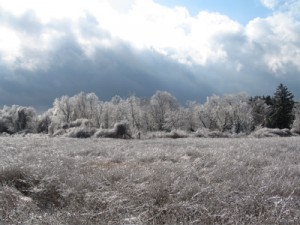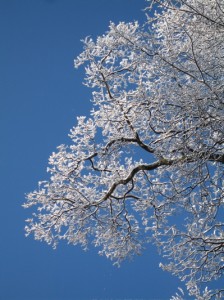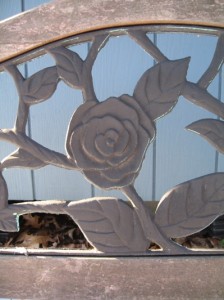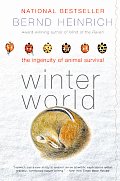Winter Is Wonderful
February 9, 2010 by admin
Filed under Seasons in the Garden, Winter

Every time I give a winter lecture (like the one I presented at the Berkshire Botanical Garden in Stockbridge, MA the other day), I can always count on several people saying, “You must be champing at the bit for spring to arrive!” Well, actually…no, I’m not.
It’s not because winter is my “off season” when I get a chance to rest and recharge. The fact is, every season is incredibly busy for me, including the coldest months. And it’s also not because I’m an avid (if only marginally talented) skier, although I admit to eying slopeside cabins in the Canadian Rockies as ideal retirement property.
I’m a four-season kind of person, which is why I live in a part of the world that’s supposed to get four distinct seasons. I have an interest in all kinds of flora and fauna, but I’m especially fascinated by the plants and animals that live where conditions are in a constant state of change. Winter is an integral part of that change, and I’m always a bit surprised by the dislike other people express for this beautiful, important season, and especially for the snow that should come along with it.

An early December storm left these branches traced in snow.
Gardeners in the Northeast should love winter and snow, for a lot of reasons. First, if we didn’t have winter, New England wouldn’t be New England. There’d be no sugar maples, no white birches, and no apple crop in autumn. We wouldn’t even have the stone walls that famously crisscross our landscape, because it’s the freeze/thaw cycle that brings rocks to the surface, where farmers have to remove them from fields.
As for snow, its importance just can’t be overstated. The day after Thanksgiving, I say, “let it snow and keep on coming.” I don’t want to see the ground until April, and I can guarantee you that the plants are with me on that one. A nice thick layer of protective snow is just the insulation they all need.
Longtime gardeners eventually begin to notice patterns—events that occur regularly, if not always cyclically. One of the recurring patterns in the Northeast is the winter where nearly every individual of a particular type of plant dies. The discovery is made in spring when gardeners begin to chat with one another about what did and did not “come back.”
This often happens with plants that are at the northern edge of their growing range in the North to begin with, such as butterfly bush (Buddleia). In Zone 5, it’s considered perfectly normal for butterfly bush to die back to the ground, even though it’s a woody plant. When a plant is living on that edge, it doesn’t take much in the way of stress to push it over the cliff.

I have a "rosy" view of winter...
Interestingly, though, it also sometimes happens with plants that are hardier overall, such as sweet autumn clematis (Clematis maximowicziana). It isn’t always obvious what happened to cause these widespread losses, but I think it’s safe to say that when the majority of all the sweet autumn clematis plants in a region die one winter, it’s probably because of some large-scale environmental factor.
All you can do is take an educated guess at the reason for these events. Things plants generally don’t like include temperatures below freezing and blasts of Arctic wind without snow cover, and rapid changes in temperature, particularly when they swing around the freezing point (15°F one day, 50°F the next). People might like mid-winter thaws, but warm interludes in what should be a cold season generally just confuse and weaken plants. A lack of snow just makes them more susceptible to damage when temperatures inevitably drop again. Gardeners shouldn’t take it too personally when these deaths occur; they don’t imply failure of the gardener.
So, I’d like to respectfully suggest that gardeners should have a higher opinion of winter and snow! Yes, snow also has its down side—for one thing, rodent damage to plants can be worse in very snowy winters—but on the whole, it’s immensely beneficial, and it’s free. If that doesn’t warm the cockles of a New Englander’s heart, I don’t know what will!

A winter reading gem: Bernd Heinrich's Winter World
Recently, I discovered a wonderful book that celebrates winter and snow in an engaging way: Winter World: The Ingenuity of Animal Survival by Bernd Heinrich. Although this is a little off the topic of gardening, it’s not at all off the topic of why a lot of people garden: a love of the outdoors. In the wrong hands, a topic like the mechanics of winter survival could be dry and uninteresting. But in Winter World, one man’s love of land and the plants and animals that occupy it makes the subject come alive. Heinrich traces the web of connections between animals and plants, and every gardener should be interested in that.
It’s all too easy for gardeners to fall prey to the fallacy that gardening is about shaping the natural world to our liking. If you allow yourself to think that, nature has a way of eventually showing you that you’re not really in control. I prefer to see gardening as a tool for learning about the processes of the natural world and especially how plants and animals interact. The puzzle of these interactions is one of the greatest stories that could be told, and winter is a big piece of it.
Read Winter World and you’ll gain a greater appreciation for how contradictory individual plant and animal life is, simultaneously tenuous and tenacious. It may help impatient gardeners live a little more in the moment of winter instead of wishing for it to end, and it’s definitely something worth pondering as Earth’s quietest season ticks by.

